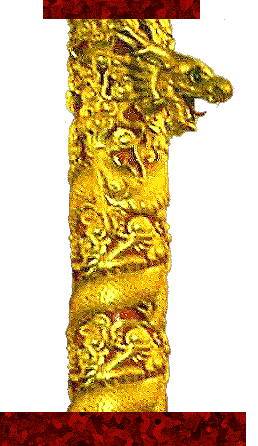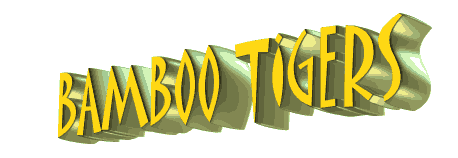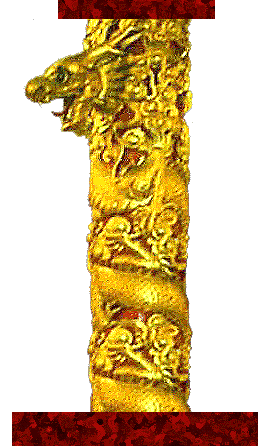| |
If the year preceding the Golden Dragon massacre had been a wounded tiger, the beast would have left a trail of blood leading straight to the restaurant's doors at 816 Washington Street. Three lesser events which occurred during that period from September 1976 to September 1977 were tantamount to shots fired at the tiger's heart. But only a prophet of biblical stature could have foreseen the Labor Day slaughter as their logical consequence. Tracking phantom spoor is easier in the informing glare of hindsight.
The first incident was the Joe Boys' invasion of the Jade Palace nightclub along the glittering Broadway Strip in North Beach in late September of 1976. On that occasion, the would-be king of Chinatown, Hotdog Louie, tumbled under a barrage that scored superficial wounds in both his legs. Also wounded was Hotdog's fellow Wah Ching, Softhead Kwan, who remained paralyzed for months.
The second was a mysterious shooting in the spring of 1977, again in North Beach, but well behind the rows of topless joints along the Strip in an area gradually becoming more and more a part of Chinatown. It does not yet, however, have the classical look of Chinatown as displayed on Grant Avenue.
Beginning at Market Street, Grant Avenue starts with a width normal to downtown San Francisco while it passes for six blocks between New Yorkish shops catering to the carriage trade. Narrowing then at a junction with Bush, it squeezes through the pailou arch marking the entry to Chinatown. For the next two blocks, Grant crests the eastern slope of Nob Hill. The shops begin to assume a subdued but clearly Oriental character.
By the time the cable car tracks intersect Grant at California Street, the principal thoroughfare of the Asian community has donned the full regalia of its colorful heritage--signs and streamers painted with Chinese characters, fascinating gift boutiques, herbal pharmacies, acupuncture clinics, bars, restaurants, markets where live fish swim in window tanks and savory roasted ducks dangle from hooks, pagoda-eaved banks, and outdoor loudspeakers in front of theaters and record shops screeching pentatonic music. Here resides the soul of Chinatown. Enticing glimpses of equally exotic side streets make them impossible for the visitor to resist exploring.
After this six-block run through a distinctly Far Eastern milieu, Grant suddenly collides with wide Broadway and abruptly disappears. Where has it gone? To the east and the west stretch the Broadway Strip's tawdry niteries, scaled lower than those of the Place Pigalle in Paris, yet a notch higher than those on Patpong Road in Bangkok.
Thus begins North Beach, at the expense of Chinatown's fabulous Grant. But, as San Francisco learned in the immigration Gold Rush after 1965, Chinatown's invisible wall is nothing if not elastic. It can stretch in any direction. All it takes is time.
A sidewise look to the northeast, beyond Columbus Avenue's oblique slash through Broadway, reveals a ragtag of a street corner lurking, with some embarrassment, behind one of the first of America's topless bars, the Condor Club. A familiar name marks the signpost. So this is what has become of the glory that was Grant!
Even more narrow than its Chinatown counterpart, and a third the length of its stretch from Market to Bush, this Grant Avenue seems at first glance to have lost its glamor. But a few steps beyond the corner lead to a district where one might hope to find cobblestones instead of concrete pavement, and indeed a sort of cobblestones are nearby, although not on Grant itself.
Italian names fade away on long-painted signs above the shops, while chic little restaurants and boutiques display crisply starched tablecloths and fishnet dresses reminiscent of Mediterranean resort towns from Nice to Piraeus. As so often happens in San Francisco, another world has been found waiting around the corner, yet even here freshly-painted Chinese symbols and names salt the first blocks with Oriental flavor.
But this region quickly grows heavily residential. Narrow streets and blind byways climb toward the steeps of Telegraph Hill and its crowning Coit Tower. Unseen is the spreading multitude of Chinese wrestling with a dwindling number of Italians in a gentle struggle to replace the neighborhood's traditionally European ethnicity with an Asian one.
It was here that the second major blood-letting of the year prior to the Golden Dragon took place.
At 2:30 on a Tuesday afternoon in late May, a Pacific Gas and Electric employee sat in a company truck parked on Kearny Street near Green. A young Chinese ran past with another hot on his heels. The pursuer held a gun and, according to the PG&E man, was "trying to take aim." "The first guy got into the red car," reported the witness. "When the other guy caught up, he went to the passenger window, aimed, and started shooting."
The victim, even after the first shot was fired, started the car and threw it into reverse. The bright red Plymouth Fury leapt backward when the victim slumped across the front seat, his foot jammed on the accelerator. The Fury knocked another parked car against a telephone pole, jumped the sidewalk and smashed into a building wall. The killer calmly leaned into the Fury, administered a coup de grace, then turned and ran off.
Police found 20-year-old Kenneth Kin Louie dead of eight wounds in the head and neck. His 18-year-old sister emerged from the nearby family home and asked a police officer for a description of the clothing worn by the victim. She could not see into the car. Upon learning that it was her brother, she wept.
Family tears were among the few shed in Chinatown for Kenneth that day. His death made a lot of Chinese merchants happy. His job as "collection man" for the Hop Sing Boys' extortion of funds from small businesses earned him few friends beyond his fellow criminals. He had already twice before been a running target for persons intent on his destruction and carried a wound in the shoulder as a reminder.
The third incident preceding the Golden Dragon wore no such shroud of mystery. Rather, it blatantly displayed itself in public contempt of lawful society.
The 4th of July 1977 brought to season's end the illicit sale of fireworks in the streets of Chinatown, an annual event in the years before and the years since. For weeks, winsome Chinese kids ranging in size from full-blown penguins to overgrown Peter Pans hustle drivers stopped at the traffic lights along Grant Avenue. "Hey, mister, you buy some fireworks real cheap?" they hawk a hundred times a day. Sometimes they get lucky. "Yeah? Tell you what to do. Hook a left here on Sacramento to the alley just before the big tunnel halfway up the hill. My buddy's wearing a red baseball cap in front the building next door to YMCA. You tell him Little Sam sent you. Pull into the alley and open your trunk. He fix you up real good."
Following instructions, the motorist swings into the alley with a knowing nod to the boy in the cap. After a few quick words and a settled price, another kid appears as if from nowhere to toss a box or more into the open car trunk. Within minutes, the whole deal is accomplished and the car speeds away through the Stockton tunnel to vanish in downtown traffic a world away from Chinatown.
As for the kids, they likewise disappear to the undiscriminating eye. Who notices a boy in a red baseball cap idling near the YMCA? But the scene is repeated countless times, moving from one clandestine location to another, from one safe stashing house to another, all over the Chinese quarter. When the traffic thins and the hour grows late, when the sight of little boys accosting passing cars or pedestrians becomes outstanding rather than lost in the crowd, the kids go home. For many of them, home means San Francisco's Ping Yuen housing project in the heart of Chinatown.
The labyrinthine block of flats, laced with corridors and punctuated by shadowed courtyards, faces Pacific Avenue on the north, Grant on the east, and Stockton on the west. A blend of lemony beige above the street and pastel colors splashed across the walls at sidewalk level, its six-and-seven-story wings house low-income tenants mostly of Chinese origin. A sparse motif of Oriental latticing in concrete on externally visible galleries and a temple-style gateway set into a protective wall on Pacific Avenue leave no doubt in a tourist's mind that this is Chinatown.
What the tourist does not see is the teeming world within, replete with Asian mystery. Unsolved murders blemish Ping Yuen's history, among them the brutal case in 1978 of a young woman raped, murdered, and cast from an upper stairway to a courtyard far below.
The project even has its own youth gang, the Ping Boys. These constitute many of the kids who peddle the fireworks every year, and a good business it is. Elsewhere in these pages, mention has been made of a truck stopped on the Transbay Bridge in 1978, its possible origin the American Gulf Coast or Mexico, its cargo fireworks with a payload value of $75,000, its ultimate destination Chinatown and the retail car-to-car market handled by the smallfry. Presumably, many other trucks got through to the Caucasian suppliers who secretly wholesale the illicit goods to the Chinese kids.
| |
|









